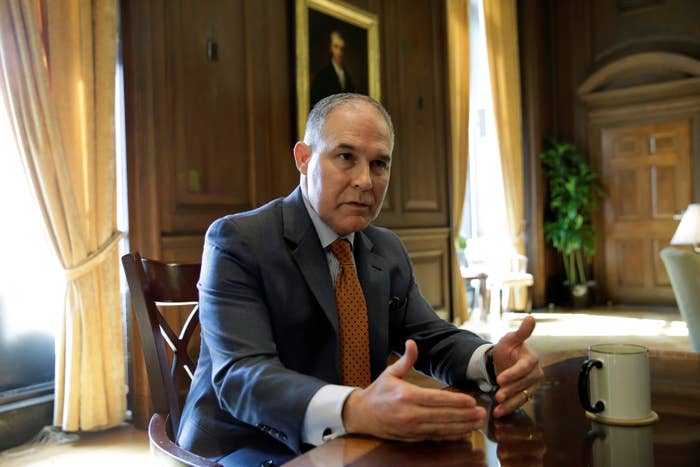
The Trump administration is reassessing strict Obama-era standards for how major coal-fired, natural gas, and nuclear power plants treat and dispose of wastewater laced with toxic pollutants, according to a court filing released late on Monday.
Two industry groups — the Utility Water Act Group and the US Small Business Administration — petitioned Environmental Protection Agency head Scott Pruitt to reconsider the rule in the spring, citing concerns about the standards being burdensome and costly. In 2015, the Utility Water Act Group, along with several energy companies, had sued the agency over the rule.
Pruitt recently told the petitioners he planned to review the main restrictions. “After carefully considering your petitions, I have decided that it is appropriate and in the public interest to conduct a rulemaking to potentially revise the new, more stringent” waste standards, Pruitt wrote in a brief Aug. 11 letter sent to the industry groups. He had already agreed to look into the rule in April, when he temporarily blocked it from being enforced.
Trump officials shared their plans to review most of the rule and asked the court to put related legal challenges on hold until that process ends, according to a filing to the 5th Circuit Court of Appeals on Monday.
“This announces the EPA will replace the 2015 pollutant limits for two major waste streams,” Betsy Southerland, former director of science and technology in the EPA’s Office of Water, told BuzzFeed News via email. Southerland helped develop the original rule and recently resigned from the agency, citing concerns including Pruitt’s efforts to review and repeal rules such as this one.
In response to a request for comment, the EPA sent a two-paragraph explanation of the contents of its court filing. The two industry groups did not respond immediately to requests for comment.
The court filing is the latest example of the EPA moving quickly to weaken or eliminate dozens of Obama-era environmental and climate regulations in response to pressure from industry. For instance, the EPA last week announced it was reviewing climate emissions standards for new cars and light trucks. Car industry groups had asked for such a review back in February.
In this case, the new rulemaking will target the so-called ELG rule, which applies to most power plants. The Obama administration finalized these standards in November 2015, estimating they would curb the amount of toxic metals, nutrients, and other pollutants that power plants annually release into US waters by 1.4 billion pounds.
The types of pollutants coming out of these plants have been linked to a range of health and environmental problems, from cancer in humans to deformities in fish.
The rule targets two main sources of waste. First, there’s the waste produced when sulfur dioxide is stripped out of the collection of gases venting into the atmosphere from a power plant. The rule imposed the first ever limits on how much mercury, arsenic, and other toxic pollutants can be in this waste.
Second, there’s the residue flushed out of the bottom of furnaces and incinerators at coal plants, called bottom ash, which is often combined with water and stored in ponds on-site. Sometimes heavy rains can cause these ponds to overflow into surrounding waterways, but other times companies may directly dump the waste into surface waters. The rule banned plants from dumping any of this waste, either intentionally or not, into waterways.
“The objective of the 2015 rule is to prevent repeats of the many environmental catastrophes caused by the failure of power company coal ash ponds, the most recent being the 70 mile long Duke Energy spill into the Dan River of North Carolina,” Southerland wrote in her exit letter.
When the rule first came out, it was hit by lawsuits on all sides. While the Utility Water Act Group and others challenged the rule for being too strict, environmental groups and others alleged the rule wasn’t strict enough.
Monday, Aug. 14 was the EPA’s deadline for reporting to the court about its plans for addressing the legal challenges.
Environmental groups are criticizing the move. “It’s hard to believe that our government officials right now are so beholden to big business that they are willing to let power plants continue to dump lead, mercury, chromium and other dangerous chemicals into our water supply,” Thomas Cmar, an attorney at Earthjustice — which represents some of the environmental groups that originally sued the EPA for not making the 2015 rule stricter, and then sued again when Pruitt put the rule on hold — said in a statement. “We will fight this in court.”
UPDATE
This story has been updated to reflect that the EPA responded to a request for comment.
CORRECTION
Thomas Cmar's name was misspelled in an earlier version of this post.
